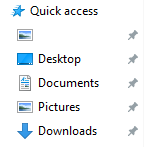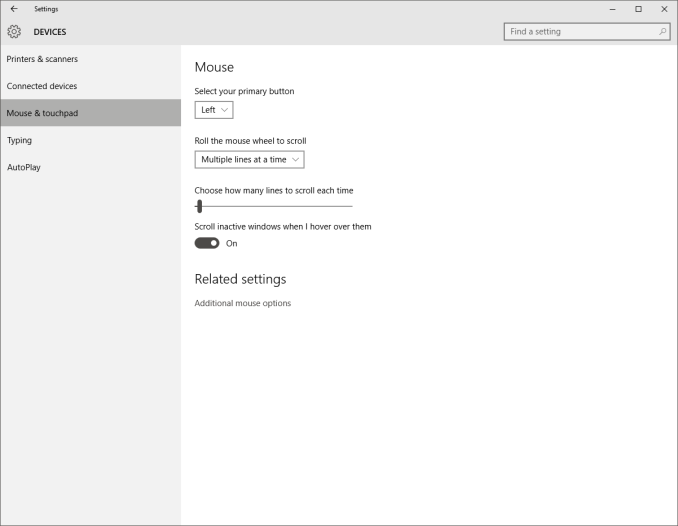The Windows 10 Review: The Old & New Face of Windows
by Brett Howse on August 25, 2015 8:00 AM EST- Posted in
- Operating Systems
- Microsoft
- Windows 10
More Desktop Changes
One of the goals of Windows 10 is to entice Windows 7 users to migrate to the new operating system. The additions we’ve seen already to the traditional mouse and keyboard interface have already been substantial, and should make most Windows 7 users comfortable. But they are not the only changes to the desktop. There is a little bit for everyone, both casual users and enthusiasts alike, so lets check out some more of the new features of Windows 10’s desktop.
Windows 8 changed up Windows Explorer, and brought in the ribbon menu. Office 2007 was the first Microsoft program to move from the file menu to the ribbon menu, and while it was controversial at the time, it is now very familiar. Moving Windows Explorer to a ribbon menu made it both easier to use with touch, as well as exposing settings and features that may have been tucked away in a submenu before. Windows 10 evolves this. Opening up Windows Explorer now greets you with a list of files you have recently accessed in the main pane. The thinking is that when you go to Explorer, you are likely looking for something you’ve used before. I won’t dispute the logic, but I prefer to see the computer view myself. Luckily it’s an easy option to change by clicking File->Change folder and search options. What I do like though is the Quick Access feature in Windows Explorer, which gives you – you guessed it – quick access to folders that are used a lot. The system will automatically add folders you go to frequently which is kind of great for discoverability, and you can add or remove any folder here. I have found it very useful, and since it is also built into the file picker for saving files, it makes it easy to get where I want to go when saving files.
Another nice feature to come to Windows Explorer is the Share contract. Windows 8 introduced contracts, which allow apps to communicate with one another over dedicated protocols, and adding it to Windows Explorer is a great way to expand them from the tablet style apps to the desktop. Share was likely the most useful contract, and I was always disappointed that the Windows 8 Charms did not offer any functionality on the desktop, so this is a great addition.
There are also small changes which improve Windows 10 over Windows 8. Things like having drop shadows back. Windows 8 went for a very flat UI, and it was clean looking but the lack of depth was not very useful with multiple windows open. Adding drop shadows back give the subtle definition around windows to make them stand out a bit more.
One of my favorite features that has come to Windows 10 is the ability to scroll an inactive window. Prior to Windows 10, and assuming you were not running a third party utility which enabled this, in order to scroll a window you had to first select it. Now, you can just move your mouse over any open window and use the scroll wheel to move whatever window you are over. You can do this on windows that are buried three or four deep – as long as you can see some of it you can scroll it. It is great when you are referencing a PDF or site, and writing at the same time, since you can continue to type while scrolling around in your reference document. For those that think this is insane, yes, you can turn it off.
Windows 8 seemed to signal that Microsoft was looking to a future past the desktop. There were some nice changes brought to the Windows 8 desktop but they were overshadowed by the changes brought in by the touch-first UI. With Windows 10, Microsoft is not only trying to bring back the focus on the desktop, they have added a lot of great features as well which should certainly entice users of both Windows 7 and 8.1 to want to switch.














293 Comments
View All Comments
Notmyusualid - Friday, August 28, 2015 - link
He is absolutely a paid shill.Another one I saw over on The Daily Telegraph too.
Notmyusualid - Friday, August 28, 2015 - link
Ridiculous answer.Why would I need to decrypt the packets? It is completely obvious they coincide exactly - with every key-stroke I make? Really, what else could it be? And we know this logging is used for search, and many other things, so what the hell else could it possibly BE?
I reckon if someone put a gun to my head I could decrypt them, but the content is obvious.
Margalus - Wednesday, August 26, 2015 - link
you have zero credibility since you keep posting the same fake photoshopped picture. Not a single thing is accurate in the garbage you keep posting..yuhong - Friday, August 28, 2015 - link
"EVERYTIME I hit a key, and everytime I open a program."Proof?
yuhong - Friday, August 28, 2015 - link
Actually, I just found out about licensing.md.mp.microsoft.com which is contacted when opening I think Windows Store apps. I wonder if Android and iOS does the same thing.yuhong - Friday, August 28, 2015 - link
FYI, someone managed to decrypt this traffic using Fiddler: https://www.reddit.com/r/Windows10/comments/3gm1e3...Notmyusualid - Tuesday, August 25, 2015 - link
Absolutely correct.kaidenshi - Tuesday, August 25, 2015 - link
It does now. Most of Windows 10's telemetry and data reporting "features" have been backported to 7 via the last few dozen updates.chrome_slinky - Wednesday, August 26, 2015 - link
Not if you did not install them.imaheadcase - Wednesday, August 26, 2015 - link
You would not know, they are security updates.